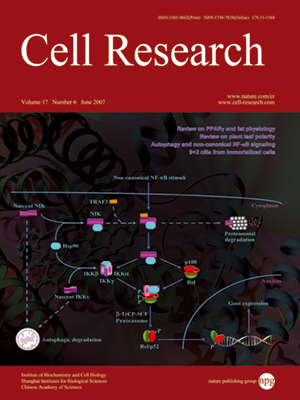
Volume 17, No 6, Jun 2007
ISSN: 1001-0602
EISSN: 1748-7838 2018
impact factor 17.848*
(Clarivate Analytics, 2019)
Volume 17 Issue 6, June 2007: 531-536
ORIGINAL ARTICLES
Up-regulation of Bcl-2 is required for the progression of prostate cancer cells from an androgen-dependent to an androgen-independent growth stage
Yuting Lin1, Junichi Fukuchi2,3, Richard A Hiipakka2, John M Kokontis2 and Jialing Xiang1
1Department of Biological, Chemical, and Physical Sciences, Illinois Institute of Technology, Chicago, Illinois 60616;
2Ben May Department for Cancer Research,The University of Chicago, Chicago, Illinois 60637, USA;
3Current address: Chiba-shi, Chuo-ku, Chibadera 1212-3, Sunshine A107, Chiba 260-0844, Japan
Correspondence: Jialing Xiang(xiang@iit.edu)
Bcl-2 is an anti-apoptotic oncoprotein and its protein levels are inversely correlated with prognosis in many cancers. However, the role of Bcl-2 in the progression of prostate cancer is not clear. Here we report that Bcl-2 is required for the progression of LNCaP prostate cancer cells from an androgen-dependent to an androgen-independent growth stage. The mRNA and protein levels of Bcl-2 are significantly increased in androgen-independent prostate cancer cells. shRNA-mediated gene silencing of Bcl-2 in androgen-independent prostate cancer cells promotes UV-induced apoptosis and suppresses the growth of prostate tumors in vivo. Growing androgen-dependent cells under androgen-deprivation conditions results in formation of androgen-independent colonies; and the transition from androgen-dependent to androgen-independent growth is blocked by ectopic expression of the Bcl-2 antagonist Bax or Bcl-2 shRNA. Thus, our results demonstrate that Bcl-2 is not only critical for the survival of androgen-independent prostate cancer cells, but is also required for the progression of prostate cancer cells from an androgen-dependent to an androgen-independent growth stage.
Cell Research (2007) 17:531-536 doi: 10.1038/cr.2007.12; published online 3 April 2007
FULL TEXT | PDF
Browse 2006


